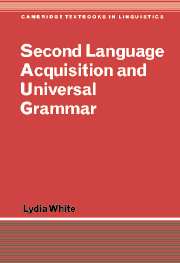Book contents
- Frontmatter
- Contents
- Preface
- Abbreviations
- 1 Universal Grammar and language acquisition
- 2 Principles of Universal Grammar in L2 acquisition
- 3 The initial state
- 4 Grammars beyond the initial state: parameters and functional categories
- 5 The transition problem, triggering and input
- 6 Morphological variability and the morphology/syntax interface
- 7 Argument structure
- 8 Ultimate attainment: the nature of the steady state
- Glossary
- Notes
- References
- Index
2 - Principles of Universal Grammar in L2 acquisition
Published online by Cambridge University Press: 05 June 2012
- Frontmatter
- Contents
- Preface
- Abbreviations
- 1 Universal Grammar and language acquisition
- 2 Principles of Universal Grammar in L2 acquisition
- 3 The initial state
- 4 Grammars beyond the initial state: parameters and functional categories
- 5 The transition problem, triggering and input
- 6 Morphological variability and the morphology/syntax interface
- 7 Argument structure
- 8 Ultimate attainment: the nature of the steady state
- Glossary
- Notes
- References
- Index
Summary
UG and the logical problem of L2 acquisition
As discussed in chapter 1, UG is motivated on learnability grounds: the subtle and abstract knowledge attained by native speakers goes far beyond the input that they receive as young children. In L2 acquisition, learners are faced with a similar task to that of L1 acquirers, namely the need to arrive at a system accounting for L2 input. In addition, L2 learners are also faced, at least potentially, with a logical problem of language acquisition, in that there are abstract, complex and subtle properties of grammar that are underdetermined by the L2 input (Schwartz and Sprouse 2000a, b; White 1985a, 1989). If it turns out that the L2 learner acquires abstract properties that could not have been induced from the input, this is strongly indicative that principles of UG constrain interlanguage grammars, parallel to the situation in L1 acquisition. This is true even if the linguistic competence of L2 learners differs from the linguistic competence of native speakers. In other words, it is not necessary for L2 learners to acquire the same knowledge as native speakers in order to demonstrate a poverty-of-the-stimulus situation in L2 acquisition; it is sufficient to show that L2 learners acquire complex and subtle properties of language that could not have been induced from the L2 input.
- Type
- Chapter
- Information
- Second Language Acquisition and Universal Grammar , pp. 22 - 57Publisher: Cambridge University PressPrint publication year: 2003



